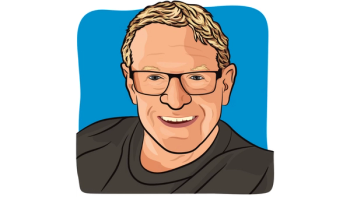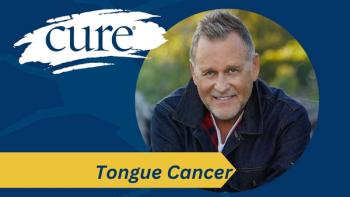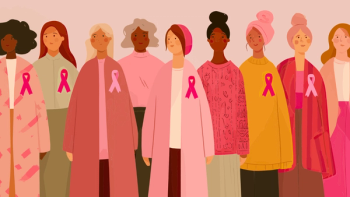
Breaking Down Treatment Variables in AYA Patients With Cancer
Key Takeaways
- AYA lymphoma patients, aged 15-39, face unique treatment challenges due to overlapping pediatric and adult oncology care, leading to potential disparities in treatment approaches.
- Recent collaborations between pediatric and adult oncology groups have advanced treatment options, emphasizing the importance of unified strategies for AYA patients.
Dr. Andrew M. Evens discussed the importance of differentiating AYA cancers from other age groups, specifically focusing on lymphoma care.
The treatment approach to adolescent and young adult (AYA) patients with lymphoma (a kind of blood cancer) is different from the approach that oncologists may use to treat their pediatric or adult counterparts, according to Dr. Andrew M. Evens.
“You would think [an AYA patient seeing a pediatric or adult oncologist] would be identical, but it often is not. Historically, we have treated patients [slightly] differently, and slight differences can sometimes be important,” Evens, the deputy director for clinical services at Rutgers Cancer Institute of New Jersey, said.
In an interview with CURE, Evens discussed the importance of differentiating AYA cancers from other age groups, highlighting what makes lymphoma in this patient group different to treat and some of the most significant research advancements to have recently emerged.
He holds multiple positions such as the associate vice chancellor of Clinical Innovation & Data Analytics at Rutgers Health; system director of medical oncology; oncology lead for RWJBarnabas-Rutgers Medical Group, RWJBarnabas Health; and professor of medicine at Rutgers Robert Wood Johnson Medical School, all located in New Brunswick, New Jersey.
CURE: What makes lymphoma in AYA patients different from cases diagnosed in children or older adults, and how does that impact treatment planning?
Evens: When we say adolescent and young adults, or AYAs… at least through the lens of the National Institutes of Health, it [includes] patient’s aged 15 to 39 [years]. The reason that age range is so important is it tends to be an overlap between our pediatric oncologists, who obviously will treat children well below age 10 and even into their 20s and sometimes into their 30s, even though that official definition goes up to 39 — usually it won't be often above 30, but certainly into the 20s.
On the other hand, an adult oncologist like myself, with different training (you go to a pediatric program for pediatric oncology or internal medicine and hematology-oncology or radiation oncology), we will usually treat our youngest patients starting at age 18 years and above, with no upper age limit. That age range from 18 to the low 30s has an overlap, and that's important because it can sometimes lead to a disparity of viewpoints and recommendations, at least historically.
When it comes to treatment planning, that's always going to be a factor: is the AYA patient, whether with Hodgkin lymphoma or non-Hodgkin lymphoma (let's say a 25-year-old), seeing a pediatric oncologist or an adult oncologist? You would think it would be identical, but it often is not. Historically, we have treated patients not radically differently, but slightly differently, and slight differences can sometimes be important.
It always [comes down to]: what is the diagnosis? What's the exact subtype of lymphoma? That's regardless of pediatric or adult. What's the stage, meaning, where is it in the body? That's similar, if not close to identical, between us, assessed with blood tests and a PET scan, a whole-body scan that we'll do. Then, it's about coming up with the best treatment based on that subtype of lymphoma and stage. Of course, we're always looking for a clinical trial.
When we say clinical trial, we don't mean experimental. We mean we're always trying to do better than the standard of care. If there's a certain standard of care, that's great. How can we do even better and/or with less side effects? So, just in terms of big-picture treatment planning, those are some of the important components.
What are some of the most significant research advancements in AYA lymphoma care that have emerged through recent initiatives?
There have been some important breakthroughs just even in the last 12 months for the treatment of patients with AYA lymphoma. I had alluded to the historical differences in how pediatric oncologists and adult oncologists might affect or treat that 25-year-old patient with, let's say, Hodgkin lymphoma very differently, meaning what type of chemotherapy, how many cycles, and the role of radiation.
Our goal in treating every patient, and certainly young patients, is, of course, cure at the highest possible rate. But goal two is to achieve that cure with the least amount of side effects as possible. When I say side effects, I mean not just during treatment, but sometimes the chemotherapy and radiation we give can have late-term consequences five, 10, 20 or 30 years down the road.
We're always thinking about all of that; we want to design the treatment that will maximize cure and minimize side effects or any toxicity. The great news is that starting about six, seven, maybe even now eight years ago, the pediatric lymphoma leaders and groups in North America, particularly the United States and Canada, came together with the adult oncology groups in the United States and Canada and just started meeting, talking, and trying to say, "Well, we're not that far apart. How can we not just come together but potentially approach and treat patients the same way?" The way we often do that is, yes, meeting in a room or on Zoom, but often how we advance cancer care, find more cures, and decrease side effects is through clinical trials, as I had mentioned.
How have recent collaborations between pediatric and adult oncology groups advanced treatment options for AYA patients with advanced-stage Hodgkin lymphoma?
We have done several clinical trials together historically. For the preceding 50-plus years, pediatric oncology did their own studies in Hodgkin lymphoma, and adult oncology did their own. You could say that not only does that lead to disparate recommendations, but it also takes longer if you're doing your own studies. However, if you do it together, you can do it faster and make bigger and better advancements.
One such example was a clinical trial called S1826 (S for SWOG was a cooperative group), and it not only involved all the adult oncology groups but also the pediatric groups. It was a randomized clinical trial testing a new immunotherapy, not new but immunotherapy — a checkpoint inhibitor that was approved for relapse disease — and bringing it to newly diagnosed patients and comparing it to a standard regimen.
The long story short is that it won; it beat the standard regimen. It not only won and beat it in terms of more effectiveness, a higher likely cure rate, or at least progression-free survival, but largely, it was also, at the same time, better tolerated. That was published in the New England Journal of Medicine last year in 2024, and that clinical trial, normally, if we were just doing an adult clinical trial, would have only included patients 18 years and above. This one included patients 12 years and above. So that breakthrough is going to impact patients down to ages 12 years and above. An important breakthrough with a new and better treatment for patients with advanced-stage Hodgkin lymphoma.
Transcript has been edited for clarity and conciseness.
For more news on cancer updates, research and education, don’t forget to




